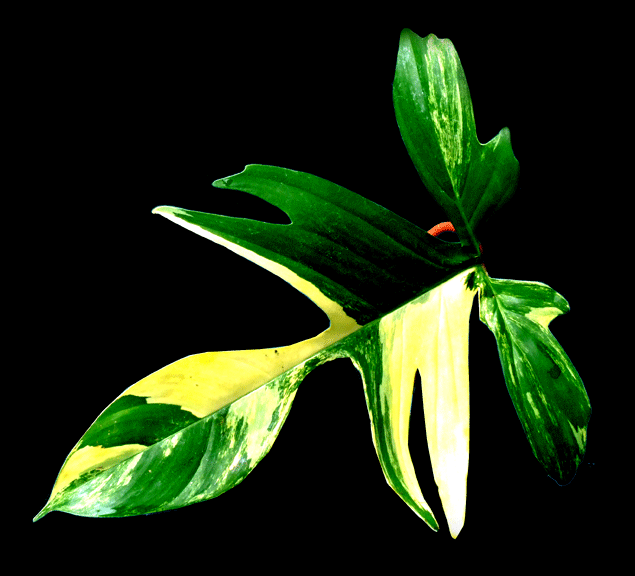![]()
Aroids and other genera in the Collection
Take the Tour Now?
Orchids
The
Exotic Rainforest
Plants in
the Exotic Rainforest Collection
In depth information on
how to grow Philodendron
species, Click this Link
Within our collection we have many species of Philodendron. If you are seeking other photos, click this link:
Philodendron 'Florida Beauty' Variegata
A Hybrid

A Hybrid: But is it Philodendron pedatum, Philodendron squamiferum, Philodendron quericifolium, Philodendron amazonicum, Philodendron laciniosum or something else?

A Hybrid

Philodendron 'Florida Beauty' Variegata
A Hybrid: But is it Philodendron pedatum, Philodendron squamiferum, Philodendron quericifolium, Philodendron amazonicum, Philodendron laciniosum or something else?
Philodendron species,
and especially hybrid forms, are
known to be highly variable and not every leaf of every specimen
will always appear the same. This link explains in greater
detail the scientific principle of natural variation and
morphogenesis.
Click
here.
If you look this one up on the internet, and you may not learn anything at all
and you
are going to quickly be confused! This hybrid Philodendron is often said to
be a hybrid variation of Philodendron squamiferum. One grower says on
his website it is a hybrid of P. laciniatum and P. pedatum.
That really is confusing since both of those are the same species, simply
synonyms!
Philodendron pedatum is the correct name for the
species in question, but not necessarily for Philodendron 'Florida Beauty'.
Philodendron laciniatum along
with Philodendron quericifolium, Philodendron amazonicum,
Philodendron laciniosum and possibly
other names are the synonym names of the same exact species: Philodendron
pedatum. Some folks are
easily confused with this concept of the same plant having multiple
scientific names but the explanation is quite simple because these plants
are nothing more than variations of the same species. Many Philodendron species have a variety of growth forms throughout their life.
And some have multiple adult forms as well. As a result, botanists
have given different names to the same plant before discovering they were
actually a single species. I'm not sure why, but many horticulturists
believe if there is any variation in a species then it simply has to be a
"new" species. In botany that is simply not correct!
If you do some research on botanical sites such as TROPICOS or the International Plant Names Index you'll find all those names lead back to one base species known as the basionym. Many plant species have a wide variety of growth forms and those forms have led to confusion even among botanists. That is exactly why some plants have so many scientific names! The basionym is the original name applied to the taxon: "basio-" from the Latin: "basis" from the Greek "bainein", meaning "step", and "-nym" from the Latin "nomen" meaning "name". It is the first step in the naming process. In many instances the genus was found to be synonymous but had the incorrect genus placement.
This hybrid (not a species) has a multi-lobed leaf with a single large lower lobe. The plant with its 15 to 23cm (6 to 9 inch) leaves is a climber and will soon climb any totem it is offered. The specimen requires high humidity to flourish. Plant in a fast draining soil mixture and avoid over watering. It is simply my personal opinion, but this hybrid appears to have something else bred into the line other than P. pedatum, I'm just not sure what the parentage actually is. Our specimen was a gift from Windy Aubrey.
If you do some research on botanical sites such as TROPICOS or the International Plant Names Index you'll find all those names lead back to one base species known as the basionym. Many plant species have a wide variety of growth forms and those forms have led to confusion even among botanists. That is exactly why some plants have so many scientific names! The basionym is the original name applied to the taxon: "basio-" from the Latin: "basis" from the Greek "bainein", meaning "step", and "-nym" from the Latin "nomen" meaning "name". It is the first step in the naming process. In many instances the genus was found to be synonymous but had the incorrect genus placement.
This hybrid (not a species) has a multi-lobed leaf with a single large lower lobe. The plant with its 15 to 23cm (6 to 9 inch) leaves is a climber and will soon climb any totem it is offered. The specimen requires high humidity to flourish. Plant in a fast draining soil mixture and avoid over watering. It is simply my personal opinion, but this hybrid appears to have something else bred into the line other than P. pedatum, I'm just not sure what the parentage actually is. Our specimen was a gift from Windy Aubrey.
Check the comparison below to decide for
yourself:

Want to learn more
about aroids?
Join the International Aroid Society: http://www.exoticrainforest.com/Join%20IAS.html
Join the International Aroid Society: http://www.exoticrainforest.com/Join%20IAS.html